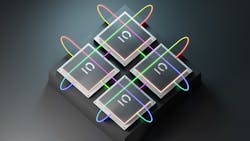Q&A with Celestial AI’s Dave Lazovsky
Celestial AI was founded by Dave Lazovsky, chief executive officer (CEO), and Preet Virk, chief operating officer (COO), in 2020. Both have backgrounds in semiconductors and photonics.
Lazovsky and Virk presciently realized that artificial intelligence (AI) and machine-learning workloads would quickly become a data movement problem rather than a compute-limited problem and today’s electronic-based interconnect technology would be unable to keep up.
Laser Focus World: Can you introduce us to Celestial AI?
Dave Lazovsky: Celestial AI is the creator of an optical interconnect technology called Photonic Fabric, which provides on-chip compute-to-compute and compute-to-memory links for disaggregated, exascale compute, and memory clusters. Its architect is our chief technology officer Phil Winterbottom, who began his career at Bell Labs in the Computer Research group and went on to co-found two successful startups: Entrisphere (acquired by Ericsson) and Gainspeed (acquired by Nokia).
Increasing data volumes within data centers are driving demand for larger bandwidths, so the industry is turning to photonics for future interconnects.LFW: What is Celestial AI doing tech-wise that differentiates you?
Lazovsky: Unlike other photonic technologies such as co-packaged optics (CPO), our Photonic Fabric can deliver data at any point on the silicon to the point of compute. And it isn’t limited to the edge of the silicon, so this shatters the package ‘beachfront problem.’ Photonic fabric offers >1.5 Tbit/s/mm2 package bandwidth, which is 25X greater than CPO. Because data is delivered directly to the point of compute and not at the edge, the latency is also 10X lower (at nanosecond latencies).
Photonic Fabric combines very high reach (100+ meters), extremely high bandwidth, and incredibly low latency because re-timers aren’t necessary. Low latency means Photonic Fabric can connect and disaggregate more servers than is possible with electrical interconnects. It also means even latency-sensitive applications can use remote memory, which wouldn’t be possible with electrical interconnects.
It’s also protocol-adaptive, supports industry standard protocols, and is compatible with interfaces like PCIe, UCIe, and other proprietary interconnects. And it can be integrated with high thermal design power (TDP) application-specific integrated circuits (ASICs) because the technology used isn’t as temperature-sensitive as CPO.
With CPO, the electro-optical(e-o)/ optical/electrical (o-e) conversions happen on a separate chiplet placed along the edge of the ASIC. Why? CPO uses ring modulators, which are very temperature-sensitive and can’t be placed beneath high-TDP ASICs. This limits the number of optical links you can have in a package to the linear perimeter—a.k.a. the ‘beachfront problem’ that limits the overall package bandwidth CPO can offer.
LFW: What does Celestial AI’s recent $100M Series B funding enable?
Lazovsky: The money raised in this round will allow Celestial AI to accelerate the productization and commercialization of our Photonic Fabric technology platform by expanding our engineering, sales, and technical marketing organizations. Given the growth in Generative AI workloads due to large language models (LLMs) and the pressures it puts on current data center architectures, demand is increasing rapidly for optical connectivity to support the transition from general computing data center infrastructure to accelerated computing. We expect to grow headcount by about 30% by the end of 2023 to be about ~130 employees.
LFW: What’s next for Celestial AI?
Lazovsky: Celestial is currently engaged with multiple Tier-1 partners, including compute and memory vendors and hyperscalers, to bring our Photonic Fabric products to the market. We’ll have more news to share within the near future.

